

 |
 |
 |
Guest - Not logged in | |||||||||||||||
Reviews > Knives > Fixed Blade > Helle Algonquin Knife > Test Report by Gail StaisilHELLEAlgonquin Knife Test Series by: Gail Staisil, Marquette, Michigan 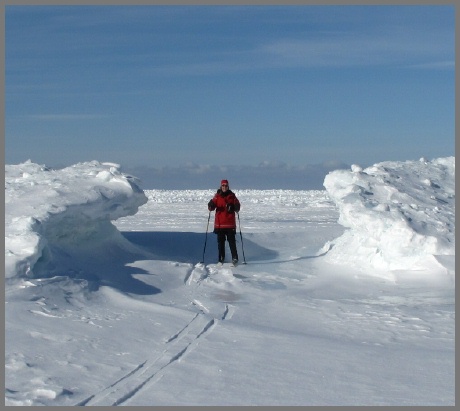
Page Contents: Initial Report: April 23, 2015 Tester Information Name: Gail Staisil Age: 62 Gender: Female Height: 5' 9" (1.75 m) Weight: 152 lb (69 kg) Location: Marquette, Michigan USA Email: woodswoman 2001 AT yahoo DOT com Product Information
Initial Impressions and Product Description 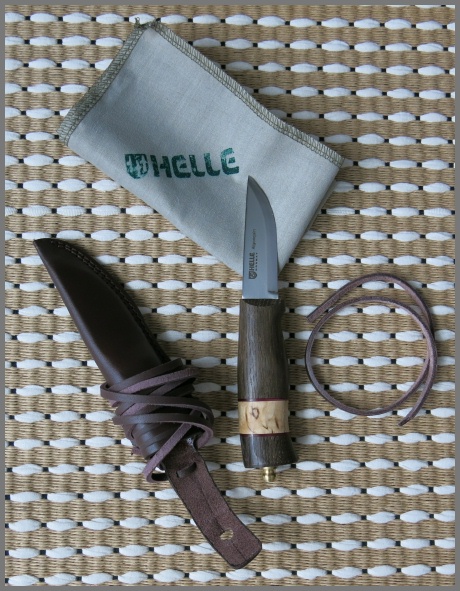 The Helle Algonquin Knife arrived in excellent condition. It was packaged with a companion sheath and lanyard. An extra piece of leather cordage was also included as well as a cleaning cloth. When I withdrew the knife from the sheath, I was amazed at the beauty of the knife. All knives I have used before have been functional but they didn't make me awestruck. My first thought was that it was too nice to use but I did realize that concept is silly. Knives are made to be used! A Little History According to information received with the products, the company was founded in 1932 in Norway. Bernt Helle was the village blacksmith and handed down the traditional skill of forging to his sons. The tradition is continued in the village of Holmedal which is surrounded by a rugged landscape. The craftsman use the knives in their daily lives so they know what makes a great knife. The Algonquin Knife The Algonquin Knife was recently designed by Laura Bombier in 2014 for "self-reliance and freedom in the wild". I would describe the Algonquin as a fixed blade knife that appears to be functional for a variety of tasks. It is not a big knife with the entire knife measuring 161 mm (6.34 in) in length. The handle portion measures 92 mm (3.58 in) and the blade portion was measured at 69 mm (2.72 in). However, it is a very sturdy looking knife in appearance as the thickness of the blade is substantial (2.8 mm/0.11 in). The handle of the knife is handmade of darkened oak and curly birch. There are very slim red leather inserts that set off the birch insert on both edges. Reportedly birch is selected for the handle because of its "hard and robust quality". The end of the handle features a brass pommel so that that the knife can be secured by inserting the pommel in a hole at the top of the leather sheath. The handle also has a very small finger guard and thumb notch and is tapered to fit my hand comfortably. The blade of the knife is made with Helle's own triple laminated steel (Helle-steel). The core of the steel is high-alloy hard edge steel which is protected by a softer 18/8 steel. The Blade is stamped with the Helle logo, Helle label, country of origin (Norway) and the model (Algonquin). The leather sheath is made of specially tanned leather treated with saddle grease which reportedly allows for increased luster and durability. The sheath has a plastic insert to protect the knife from cutting through the leather. The sheath includes a lanyard (42 in/107 cm) so the knife is made to be worn around the neck. I have never worn a knife in this manner so I will see if it works for me. The lanyard is long enough that I could wear the sheath diagonally across the chest if desired or just hanging straight down. Otherwise, the manufacturer included a shorter piece of leather (14.5 in/36.83 cm) which probably could be used to tie the sheath onto a waistbelt or other. Of course it could be just stored in my pack too. Maintenance Just as a great knife begs to be used, it also requires maintenance to keep it in fine condition. According to the manufacturer Helle knives are designed to "retain their sharpness for a long time and to be a lifetime outdoors companion". The handle should be dried with a soft cloth when wet and it should be waxed from time to time. The sheath should be rubbed with colorless grease or wax to keep it soft and it should be dried at room temperature if wet. The blade can be sharpened using a diamond tool or whetstone. The knife bevel should be placed flat to the sharpening stone working the entire blade. There are further instructions on the website for knife sharpening tips. I look forward to testing the Algonquin in the field. As a side note, The meaning of Algonquin is very well known in this area due to the Native American tribe of the same name. Top of Page Field Report: July 7, 2015 USA Locations and Conditions During the testing period I have spent twelve days backpacking and have enjoyed the outdoors most other days. Locations of all trips were in the State of Michigan and ranged from lakeshore to boreal forest. Elevation ranged from above 600 ft (183 m) to 2,000 ft (610 m). 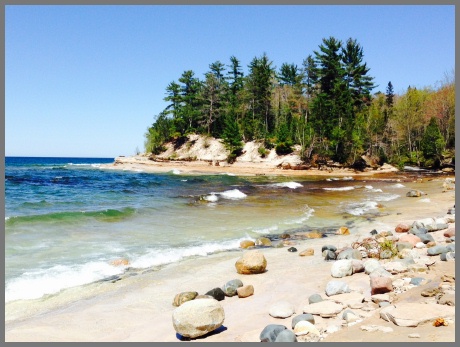 Location of Trip #1: Pictured Rocks National Lakeshore, Upper Peninsula of Michigan Length of Trip: 2 nights (May 20-22) Type of Trip: Trail Pack Weight: Approx: 23 lb (10.4 kg) Sky and Air Conditions: Sun and clouds; light winds Temperature Range: 22 to 60 F (-6 to 16 C) Location of Trip #2: Isle Royale National Park, Lake Superior - State of Michigan Length of Trip: 9 days/8 nights (June 9-17) Pack Weight: Approx 29 lb (13.15 C) Sky and Air Conditions: Cloudy, rain and sun Precipitation: 0.33 in (0.84 cm) Temperature Range: 41 F to 70 F (5 C to 21 C) ------------------------------------------------------ Trip Talk 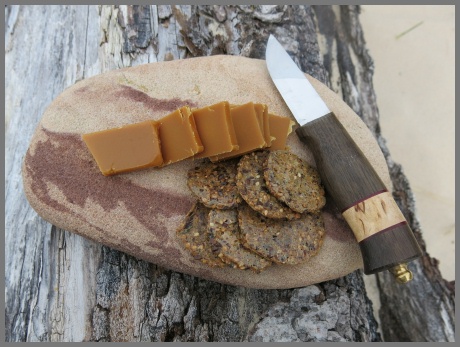 During the field test period I was privileged to carry the Helle Algonquin Knife with me during two solo backpacking trips both along Lake Superior (total of twelve days). I also packed the knife for day trips and wore it around my neck during a fishing trip. The weather varied during these trips but for the most part it was rather cool with some episodes of rain. The Helle Algonguin also got quite a bit of use at home. My very first experience or project with the knife was to cut a length of garden hose to make a new connector piece that goes from faucet to hose holder. I was more than careful as I cut the very thick rubber hose. It didn't slice right through real fast as I didn't put much pressure on the knife at first. The knife blade is rather stout but cleanly cut through the hose well enough when I exerted more power however. At home I continued to use the knife for cutting rope, cardboard, packaging tape and of course food! It slices through food handily even more difficult-to-cut ones like rutabaga. Recently it has seen a lot of use for melons of different sorts. Some of them have rather tough rinds but it wasn't a problem. The short blade isn't ideal for the length of them but I am not picky about the appearance of the pieces before I eat them! 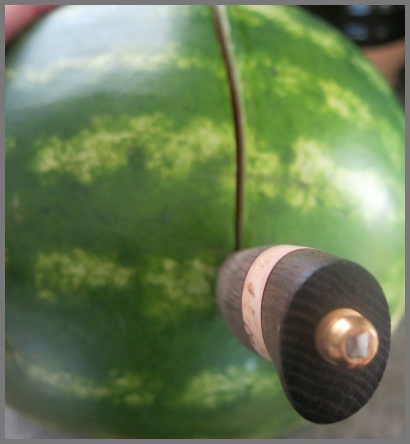 On the first backpacking trip I used it to cut off the tops of food packaging, with a magnesium flint striker and for cutting Norwegian breakfast cheese (in the picture above at Pictured Rocks National Lakeshore, I found a handy sandstone rock to cut it on although that wouldn't have been necessary!). I also made a fire stick for fun even though I didn't have a fire. During the second trip to Isle Royale National Park I mostly used it to cut cheese and packaging as well as with my flint striker (produces some nice sparks to light my stove). I was glad I didn't need it for first aid or emergency fires (the majority of the island is a fire-free zone). When I replace the knife in the sheath I make certain that the leather strap fits over the pommel. The hole is slightly tight so I haven't had to worry about it falling off. I have worn it as a neck knife on the provided lanyard (which is new to me) but on my second trip I stowed it in a handy pocket on the pack. I usually only wipe the knife off with a clean cloth while I am out in the field. At home I often do the same thing but have a faucet to put it under for a better rinse. I then wipe it dry and replace it in sheath. I am sure there is a lot more this knife can do and I will attempt more during the long term period. So far I really like the Algonquin as it is just the perfect size and weight for me. I do own other fixed blades but they are much heavier and bulky so I have been less enthused about taking them on all trips. I always carry some sort of knife on my solo trips but not always on group outings (which is less common for me). As a side note, the Algonquin Knife has already been coveted by more than one friend. It truly is a beautiful work of art but also very practical....the best of both worlds indeed. Top of Page Long Term Report: September 6, 2015 USA Locations and Conditions During the testing period I have spent eight days backpacking and have enjoyed the outdoors most other days. Locations of all trips were in the State of Michigan and ranged from lakeshore to boreal forest. Elevation ranged from above 600 ft (183 m) to 2,000 ft (610 m). Location of Trip: Grand Island National Recreation Area, Lake Superior - State of Michigan Length of Trip: 2 days/1 nights (July 8-9) Pack Weight: Approx 22 lb (10 kg) Sky and Air Conditions: Sunny Precipitation: None Temperature Range: 42 F to 74 F (6 C to 23 C) Location of Trip: Isle Royale National Park Length of Trip: 6 days/5 nights (August 21-26) Pack Weight: 26 lb (11.8 kg) Sky and Air Conditions: Cloudy, rain, and very little sun Precipitation: 1.12 in (2.84 cm) Temperature Range: 43 F to 78 F (6 C to 26 C) Location of Trip: Grand Island National Recreation Area Length of Trip: 2 days, 1 night (September 3-4) Pack Weight: 23 lb (10.4 kg) Sky and Air Conditions: Warm, humid and sunny Precipitation: None Temperature Range: 58 F to 76 F (Humidity ranged from 71-99 percent) ------------------------------------------------------ Trip Talk During the long term test period I first traveled to Grand Island National Recreation Area. This was a short trip of two days with lots of down time. Upon arriving at camp I noticed there was a bunch of branches that someone had recently cut down to presumably roast their hotdogs or something. It bummed me out that some tree branches were sacrificed. I decided though that it was a good opportunity to use the knife on wood that was already destroyed so I set about carving them. It took me awhile to use the knife as I was being extra careful that the knife wouldn't slip. My next backpacking trip was to Isle Royale National Park. Although the trip was six days in length, I really didn't use the knife as much as I thought. I carried it inside my backpack and took it out for meal prep at camp. It was also used to open packaging. My next trip was back to Grand Island National Recreation Area to circumnavigate around the island (over 21 mi/34 km). I carried the knife in my food bag so that it would be handy at mealtime. I had cheese to cut as well as packaging. Also played around making firesticks again. I have also continued to use it at home for ordinary tasks such as opening boxes and chopping and peeling food. I also have carried it in my daypack for many outings. Most uses were food related. I haven't noticed any decrease in sharpness of the knife. It continues to cut through without effort. The sheath has held up well and hasn't needed treatment yet. I must say that more than once I have put the knife in the sheath backwards when I am not looking (oops). Of course I find out quick that the strap doesn't fit over the pommel that way. I usually only wipe the knife off with a clean cloth while I am out in the field and at home I just give it a quick rinse with a drop of soap. The finish of the handle of the knife is dull but I hope to use some sort of wax on it soon. The manufacturer just uses the generic word "wax" so I hope that beeswax will be sufficient. Overall I am really pleased with the performance, size and weight of the Algonquin. It truly is the perfect knife for me as others I have had haven't been as stout or they are much too large to want to carry on all my trips. This seems to be a good match for survival tasks such as starting a fire with fire sticks as well as camp tasks. I hope to continue using the Algonquin for a very long time! Pros
Cons
Thanks to Helle and BackpackGearTest.org for this opportunity to test the Algonquin Knife. This concludes the Long Term Report and the test series. Top of page Read more reviews of A/S Helle Fabrikker gear Read more gear reviews by Gail Staisil Reviews > Knives > Fixed Blade > Helle Algonquin Knife > Test Report by Gail Staisil | ||||||||||||||||